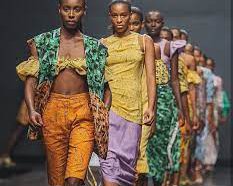This @voguebusiness article introduces us to emerging designers from Africa who will be presenting their Spring/Summer 2023 collections at Lagos Fashion Week from 26 to 30 October. There will be 10 emerging brands, focused on sustainability and social impact. The goal: to use the event to strengthen Africa's circular economy and raise awareness of the need to reduce the impact of fashion. [Meet the young designers shaking up sustainable fashion in ... – Vogue]
Some of Africa’s most prominent fashion designers, from Iamsigo to Maxhosa Africa, will show their Spring/Summer 2023 collections at Lagos Fashion Week on 26-30 October. Alongside them on the schedule will be 10 emerging, sustainability and social impact-focused brands from across the continent. The aim: to use the event to strengthen Africa’s circular economy, and raise local awareness of the need to reduce fashion’s impact.
This season, Lagos Fashion Week extended its sustainability incubator, the Green Access Initiative, beyond Nigeria for the first time since the programme launched in 2018. There were 534 applicants, and of the 10 selected to take part, five are from West Africa; three are from South Africa; one is from East Africa; and one is from North Africa. All use innovative and creative sustainable techniques, from textiles waste to sustainable dyes, which have the potential to scale.
The wider fashion landscape has a lot to learn from these smaller designers who are using textile waste and other sustainable practices to build a circular business model, says Orsola De Castro, founder of the non-profit Fashion Revolution and a judge for the British Fashion Council’s Newgen programme, who is a mentor for the Green Access Initiative. “We know that the majority (or a huge amount) of our waste ends up in different countries in Africa and solutions tend to develop right there, where there is a problem.”
The initiative was launched to spotlight a more considered approach to design and tackling waste, says Lagos Fashion Week founder Omoyemi Akerele. “These designers have a vision to strengthen the circular economy within the continent.”
As consumer interest in sustainability grows — from materials to the treatment of workers in the supply chain — providing these brands with support needed to scale and transform the luxury fashion industry is important, De Castro adds. She has been working with upcycling designers in Ghana, Nigeria, Kenya and Zimbabwe, as well as on the Green Access programme, to help support the designers’ development, identify gaps and help refine their proposition — such as quality, cut or story — in order to grow their businesses on a global scale. Green Access alumni such as Pepper Row, Maliko Studios, Kadiju and Cute-Saint are now stocked by retail platforms including The Folklore and Industrie Africa.
This year’s participating designers will have the opportunity to showcase their collections during fashion week and gain access to mentorship and in-depth workshops led by industry leaders such as De Castro and fashion journalist and lecturer Tamsin Blanchard. There is no cash injection now, but the long-term goal is to support the designers with a grant at the end of a year-long incubation period.
Sustainable production
One of this year’s Green Access participants, Nigerian designer Peter Oshobor, launched gender-fluid ready-to-wear brand Oshobor in 2020. To make garments such as cardigans, he uses waste wool from salons and knitters in Benin, Nigeria, where he is based. “Here in Nigeria we have a lot of things that are affecting us, and waste is one of them,” he says.
A lack of resources is a common challenge that brands working with textile waste encounter. Oshobor often reworks ideas and collections to coincide with the level of waste wool he has managed to collect. “Sometimes, I would want to make a very big design, with a lot of colour, but I do not have enough waste,” he says. “I am limited to my particular environment; not everywhere you go can you find waste wool.” Scaling with a small team of five and limited resources is challenging, but he aims to expand his sourcing beyond Benin and incorporate other forms of textile waste.
Adaora Soludo, founder of womenswear brand Aorah, based in Abuja, Nigeria, produces small collections twice a year. “We create limited pieces and make sure we’re not over producing,” she adds. “We try to create around 10 looks which we launch twice a year.”
Working closely with an external production studio based in the UK enables control of the production process and the quantity of garments produced. This also allows Aorah to be reactive: “If there is additional demand then we can start producing a bit more, but we try to keep it as tight as possible,” says Soludo. Her biggest market for sales is the UK, followed by Nigeria. However, she says the brand has also seen an increase in orders from the US and Japan thanks to retail partner Wolf & Badger.
Keeping traditional and sustainable textiles alive is an important goal for Soludo. Aorah works mainly with Akwete, a textile that is traditionally hand woven by women in Abia state in Nigeria. Soludo says many such textiles are “going into extinction and being forgotten about”, and weaving communities are at risk of losing their livelihoods. “We’re trying to keep that industry and that textile alive.” Among other efforts, she has donated looms to the weaving community.
Using garments as a vehicle for telling stories from the continent is important for many designers in Africa. Thebe Magugu and Maxhosa Africa are among those to have incorporated this into their collections. The hope is that storytelling through fashion can lead to wider social and political change.
In his SS23 collection, ‘I Saw a Bullet Destroy a Flower Before it Could Bloom’, Green Access Initiative participant Sipho Lushaba uses garments to explore how recent lootings in Johannesburg are affecting the local community. The South African designer, who set up his streetwear brand SVL Designs in 2020, recalls friends, family and the local community arranging a funeral for a young man who was shot. “I took the bullet shell casings and incorporated that into the collection,” he says. The process involved cutting the casings in half and weaving them into the garments. “I wanted to share that story.”
All of his garments are handmade, and he offers free repairs, as well as teaching customers how to wash pieces that are hand painted. Turnover is under 180,000 South African Rand ($10,000). For him, the Green Access Initiative is a path to profitability. “We are gaining more knowledge and actually learning how to market ourselves and how to push the business forward,” says Sipho. “Having a profitable business is key for me to be able to continue creating.”
Knowledge is power
Kenyan-based designer Ria Sejpal, who founded her gender-fluid brand Lilabare in 2017, had originally applied to be a part of this year’s Green Access Initiative talent pool, however Akerele believed other designers could learn from her sustainable practices and put her down to run a workshop instead.
Her course, ‘Designing with Nature’, teaches designers how to use natural eco-friendly fibres and dyes to create a whole-system approach to sustainable fashion from the supply chain to the impact on the consumer chain. The five-year-old brand is based in Nairobi, Kenya, where the majority of its production takes place. Sejpal also founded Tama, a boutique that stocks a collection of artisanal designers made in Kenya, which is located inside the Swahili Beach Hotel in Diani, Kenya.
Sejpal’s SS23 collection is made entirely from her signature textile. “It’s 100 per cent traceable, local origin to the East African region and it’s dyed with vegetables and botanicals, [using a technique] I’ve been developing for several years,” the designer explains. Closely monitoring the material at each stage of production allows for traceability: “The [rain-fed] cotton plants originate in Uganda and Kenya, and are spun into yarn in Kenya by a local unit.” The yarn is then dyed by her team of artisans using her botanical techniques and the material is later hand-loomed in Nairobi.
Senjpal is sharing her design techniques as well as the strategic framework so that other designers can apply these learnings to their own ecosystems, she says. “The good thing about sharing information is that, yes, people can learn. But, the main point of this course is that everybody’s immediate environment and individual ecosystem is different… If I take a designer who is practising in Angola or in Senegal or in Nigeria or South Africa, those ecosystems are entirely different and the strengths of each one needs to be harnessed by the designers.”
Oshobor says the Green Access Initiative courses help to spotlight other sustainable practices. “There is nowhere that says our outfits will not end up in landfills,” he says. “We should also find ways to recycle our outfits and create opportunities for our clients to say ‘OK, I want to rework this into something else’.”
Peer-to-peer mentoring is vital, says De Castro. “The way to support young designers is to create cohorts, to create groups. Putting a lot of people together strengthens rather than weakens their proposition.”
Key takeaway: The designers selected as part of Lagos Fashion Week’s expanded incubator are finding innovative ways to build brands based on sustainable and circular values — from upcycling waste wool to helping local weaving communities by using traditional textiles and techniques. Lagos Fashion Week wants to use its platform to help these emerging brands scale, with the wider goal of educating consumers — and other brands — in Africa on sustainable fashion.



